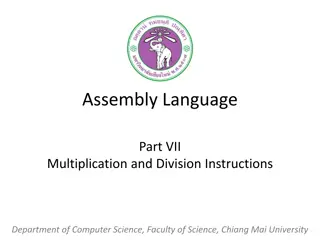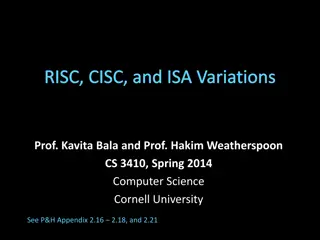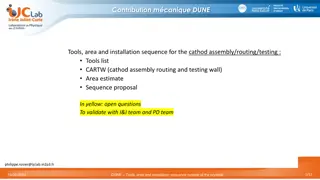An Anti-Bullying Assembly
This assembly educates Year 6 students about the different forms of bullying, such as cyberbullying and face-to-face bullying. It emphasizes the importance of using strength to uplift others, rather than to harm them. The assembly includes examples of bullying, the rights of every child to a safe le
3 views • 10 slides
Faculty Assembly Annual Meeting Highlights 2023
The Faculty Assembly Annual Meeting held on July 26, 2023, showcased various key presentations including the State of the Medical School address, discussions on addressing social determinants of health, updates from the Faculty Assembly President, and insights from the Admissions and Curriculum Comm
2 views • 30 slides
Insights into Genome Assembly and Shotgun Sequencing
Explore the world of genome assembly, shotgun sequencing, and the fundamental concepts behind deriving genomes from large sets of sequencing reads. Learn about the complexity and core algorithms involved in contemporary genome assembly processes. Discover how the shotgun concept has revolutionized g
2 views • 66 slides
Understanding MIPS Part II: Memory Organization and Instructions
Explore the intricacies of Memory Organization in the context of MIPS architecture, covering topics such as Memory Transfer Unit, Word Alignment, Load and Store Instructions, Making Decisions with Conditional Branching and Unconditional Jumps, Loops, Arrays and practical exercises. Learn about the m
16 views • 43 slides
MIPS CPU Design Using Verilog and Instruction Set Architecture Overview
Explore the world of MIPS CPU design using Verilog with a deep dive into Instruction Set Architecture (ISA), SPIM instruction formats, addressing modes, and more. Learn about the key components such as Program Counter (PC), Instruction Memory (IM), Register Files (RF), Arithmetic Logic Unit (ALU), D
1 views • 29 slides
Introduction to Intel Assembly Language for x86 Processors
Intel Assembly Language is a low-level programming language designed for Intel 8086 processors and their successors. It features a CISC instruction set, special purpose registers, memory-register operations, and various addressing modes. The language employs mnemonics to represent instructions, with
2 views • 12 slides
Multiplication and Division Instructions in Assembly Language
Explore the concepts of multiplication and division instructions in assembly language, including MUL, IMUL, DIV, and IDIV operations. Learn about word and byte division, how to perform these operations using registers, memory, and variables, and understand the terminology and procedures involved. Di
0 views • 24 slides
Synod Assembly Schedule and Prayer Offerings
The Synod Assembly, scheduled for Tuesday, April 19th, 2022, will see representatives from different parishes come together for prayer, discussions, and group activities. The event will feature various sessions such as spiritual conversations, group presentations, and a closing Mass. Participants wi
1 views • 21 slides
Tips for Tackling Assembly Drawings in HSC Yr 12 Engineering Studies
When approaching assembly drawings in HSC Yr 12 Engineering Studies, start by analyzing the question and identifying key criteria. Follow AS1100 standards, focus on dimensions and notes, align components carefully, and add detail progressively. Use simple drawing tools and apply sectioning where nee
1 views • 10 slides
Overview of MIPS Arithmetic and Logic Instructions in COE 301
MIPS Architecture consists of R-Type and I-Type instruction formats for arithmetic, logical, shift, and immediate constant operations. It includes a variety of general-purpose registers and specific units for execution, floating-point operations, and memory handling. The presentation outlines the st
2 views • 29 slides
Introduction to Assembly Language Syntax and Program Data
Learn about the syntax of assembly language and how data, variables, and constants are used in programming. Explore the basic instructions and the translation of high-level language into assembly language. Discover the role of an assembler in translating assembly language programs into machine langu
4 views • 36 slides
Understanding Assembly Language and 8086 Microprocessors
Dive into the world of Assembly Language, data representation, and 8086 microprocessors. Explore topics like memory organization, integer representation, and computer registers. Learn about the structure and functionality of machine language instructions, as well as the convenience of using assembly
2 views • 36 slides
Understanding Assembler Directives and Symbols in Assembly Language
Assembly language is a low-level programming language used for computers, microprocessors, microcontrollers, and ICs. It consists of instructions and directives (pseudo instructions). Assembler directives are statements that guide the assembler during the assembly process. Categories of directives i
3 views • 39 slides
Introduction to 8086 Assembly Language Programming
Assembler directives play a crucial role in guiding the assembly process for 8086 assembly language programming. They dictate how operands are handled, memory organization, and more. This content covers essential directives such as ASSUME, DB, DW, DD, DQ, and DT, providing syntax examples and explan
3 views • 29 slides
Understanding Activation Records and Stack in Assembly Programming
Explore the key concepts of activation records and the stack in assembly programming, including their roles in function calls, memory management, and variable storage. Gain insights into the low-level layout of variables, call conventions in MIPS and x86, and practical examples illustrating stack op
2 views • 66 slides
Advanced Techniques for Multiplication Performance Improvement
Explore advanced methods to enhance multiplication performance by utilizing shifts and add/subtract operations instead of traditional arithmetic. The solutions provided involve hexadecimal number pairs, demonstrating the best ways to calculate products efficiently. Furthermore, a challenge is presen
2 views • 59 slides
Performance Analysis of Different MIPS Processors
This analysis compares two different implementations (P1 and P2) of the same instruction set based on clock rates, CPI values, peak performances, and execution times on a 3GHz MIPS processor. The performance trade-offs for changes made to an MIPS process are explored using a breakdown of different p
0 views • 42 slides
MIPS Single-cycle Datapath Analysis for Instruction SW
Examine the operation of the single-cycle datapath for a specific MIPS instruction "SW.R4,-100(R16)". This analysis covers the instruction word value, register numbers, control signals, and the logic diagram implementation. Dive into details like instruction word encoding, register file operations,
0 views • 55 slides
District Training Assembly May 12, 2018 - Planning for a Successful Rotary Year
The District Training Assembly on May 12, 2018, focused on preparing President Elects and Assistant Governors for the upcoming Rotary year. The event emphasized the importance of strategic planning, goal setting, and collaboration among clubs. Key areas such as club administration, membership growth
1 views • 16 slides
Overview of 8086 Assembly Language Arithmetic Operations
The 8086 assembly language provides instructions for arithmetic operations such as addition, subtraction, and comparison. These operations are essential for manipulating data in memory and registers. The instructions support various operand types, including registers, memory locations, and immediate
0 views • 24 slides
Harness Assembly Work Instructions for Electrical Wiring
The work instructions outline the preparation, termination, splicing, and assembly steps for harnessing electrical wires in a structured and organized manner. Specific guidelines on using small and large Daniels for different wires, grounding shields, terminating with heat shrink tubing, and crimpin
0 views • 9 slides
Understanding RISC, CISC, and ISA Variations in Computer Science
Explore the differences between RISC and CISC architectures, along with variations in Instruction Set Architecture (ISA). Dive into the intricacies of processor design, performance factors, and assembly languages. Get insights into the concepts of control units, memory units, pipelines, and datapath
0 views • 37 slides
Highlights of General Assembly 2021 Online Meeting
The General Assembly 2021 Online Meeting saw significant decisions including the installation of Rev. Hamish Galloway as Moderator for 2021-2023, approval of Memorial Minutes for 44 ministers, acknowledgment of ordination anniversaries, announcement of Rev. Rose Luxford as Moderator-Designate for 20
0 views • 18 slides
Mechanical Contributions & Installation Sequences for Cathode Assembly in DUNE Project
This document outlines the tools, area requirements, and installation sequence for the cathode assembly, routing, and testing in the DUNE project. It covers tool lists, area estimates, shipping box specifications, handling instructions, and equipment needed for ground and underground operations. The
0 views • 12 slides
Understanding Assembly Language Programming for Computing Layers
Assembly language is a low-level programming language that enables direct interaction with a computer's hardware components. This content explores the fundamentals of assembly language, the relationship between human-readable machine language and binary code, an assembly language program for multipl
0 views • 31 slides
Understanding MIPS I/O and Interrupt Handling
Delve into the world of MIPS architecture, exploring how I/O operations and interrupts are managed. Learn about memory organization, system functions, I/O registers, and kernel data. Discover how SPIM facilitates input and output handling, including reading from the keyboard and managing output. Div
0 views • 18 slides
Understanding MIPS Instruction Sets and Binary Execution
This lecture covers the mapping of MIPS instructions to binary for execution, the use of pseudo-instructions to improve code readability, and the handling of large constants. It discusses levels of representation and interpretation, the concept of stored-program computers, addressing in memory, bina
0 views • 50 slides
HBWD Stripline Kicker Integration Details
This document provides detailed information on the HBWD Stripline Kicker integration, including global assembly key, spare parts management, shielding port assembly, elliptical bellow requirements, machine integration schemes, and more. It outlines the availability of standard and non-standard parts
0 views • 12 slides
Understanding MIPS Functions and Calling Conventions
MIPS functions in assembly language are called using the 'jal' instruction, passing arguments in specific registers. Functions must end with 'jr $ra' and have explicit declarations. MIPS functions are stored separately from the main function in memory. The 'jal' instruction jumps to a specified addr
0 views • 18 slides
Introduction to MIPS Assembly Programming with MARS
Introduction to MIPS Assembly Programming with MARS including instructions, I-Type format, register initialization, addi instructions, and translation to machine code using an assembler. Learn how to perform basic arithmetic operations in MIPS assembly language.
0 views • 61 slides
Understanding MACRA and MIPS for Post-Acute Care Providers
Explore the key provisions of MACRA impacting post-acute care (PAC) providers, including the Merit-based Incentive Payment System (MIPS) and Advanced Alternative Payment Models (APMs). Learn about quality reporting requirements, payment structures, and participation options under MACRA to optimize r
0 views • 20 slides
Understanding MIPS Arithmetic Logic Unit (ALU)
The MIPS ALU is the heart of computer calculations, performing functions like add, and, or, and sub. This article delves into designing a full ALU, starting from a 1-bit full adder to a 32-bit ALU. It explores how operations like and, or, and addition are carried out within the ALU, and how to imple
0 views • 28 slides
Exception Handling and Interrupts in MIPS Architectures
Exception and interrupts in MIPS play a crucial role in handling unexpected events and external requests efficiently. Exceptions include changes in control flow, arithmetic overflows, and hardware malfunctions, while interrupts are externally caused events like I/O requests. When an exception occurs
0 views • 29 slides
Understanding Computer Architecture: Exploring MIPs, Assembly Code, and BIOS Functions
Dive into the world of computer architecture with a focus on MIPs assembly language, basic program formats, BIOS functions, and system calls. Learn about the role of the OS kernel, memory addresses, and control flow in executing programs efficiently.
0 views • 16 slides
Exploring Feed Check Valve Assembly in Mechanical Engineering Lab
Dive into the detailed assembly drawings of a feed check valve prepared by Professor Anupam Saxena and his team in the Mechanical Engineering Compliant and Robotic Systems Lab at the Indian Institute of Technology Kanpur. The drawings highlight various components like the body, cover, valve seat, sp
0 views • 17 slides
Detector Assembly and Cryogenics Requirements for ILD Project
The ILD project involves assembling detectors using pre-assembled pieces on surface and lowering them into the assembly area. The detectors are equipped with various components like muon detectors, solenoids, and calorimeters. Magnetic field measurements are carried out during the assembly process.
0 views • 11 slides
MIPS 2022 Updates and Program Recap for Large Practices
Explore the latest updates for the Merit-Based Incentive Payment Program (MIPs) in 2022, including performance year changes, quality category considerations, penalty mitigation strategies, and historical thresholds. Learn how MIPS rewards clinicians for high-quality, cost-effective care under MACRA.
0 views • 27 slides
Understanding Engineering Assembly Drawings and Detail Requirements
Engineering assembly drawings play a crucial role in providing detailed information for the manufacture and assembly of machines and structures. Quality assurance requirements, working drawings, and detail drawing specifications are essential aspects covered in this content. Properly created assembl
0 views • 20 slides
Understanding Context Switching and User-Kernel Interaction in Operating Systems
Context switching in operating systems involves a seamless transition between user-level threads without the kernel's awareness. User-level code manages register state and stack pointers, while user-kernel mode switching requires changing processor privilege levels and agreement on information excha
0 views • 25 slides
Understanding Instruction Set Architectures (ISAs) in Computer Science
Explore the concepts of RISC, CISC, and ISA variations in computer architecture. Dive into the differences between MIPS, ARM, X86, and other ISAs, focusing on load/store, arithmetic, control flow, and more. Gain insights into the evolution and variations of ISAs, and discover the alternatives beyond
0 views • 37 slides







































